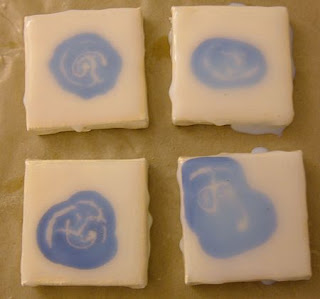On day 8 in the studio, I printed 3 more sheets/12 more pages of the 100 page accordion book that I'm doing for one of my other projects (click here to see one of those). I then turned to some small, 2" x 2" canvases, on which I painted a layer of iridescent paint, and then poured a small pool of sepia fluid acrylic:
As they used to say on Blue Peter (UK telly reference), 'Here's one I made earlier.' (Or was that 'Vision On'?).
I separated these into groups and poured different kinds of gels over them. Here are the ones with gel medium on them:
They're not really blue: that's just the temporary effect of the gel sitting on top of the sepia. The gel will be completely transparent when it dries.
Then I took some 6" x 6" panels and added a layer of drawing, using the needle applicators:
If you click on those two images and embiggen them, you might be able to see that there are several layers of drawing, each separated by a layer of clear gel.
Process is important - working with material, moving stuff around, making things messy - but it's just as important to recognise the moment when it's time to turn back to the drawing. All painting is drawing. All drawing is painting.
Tomorrow, it's back to the big canvases.
 Subscribe to Praeterita in a reader
Subscribe to Praeterita in a reader
As they used to say on Blue Peter (UK telly reference), 'Here's one I made earlier.' (Or was that 'Vision On'?).
I separated these into groups and poured different kinds of gels over them. Here are the ones with gel medium on them:
They're not really blue: that's just the temporary effect of the gel sitting on top of the sepia. The gel will be completely transparent when it dries.
Then I took some 6" x 6" panels and added a layer of drawing, using the needle applicators:
If you click on those two images and embiggen them, you might be able to see that there are several layers of drawing, each separated by a layer of clear gel.
Process is important - working with material, moving stuff around, making things messy - but it's just as important to recognise the moment when it's time to turn back to the drawing. All painting is drawing. All drawing is painting.
Tomorrow, it's back to the big canvases.



